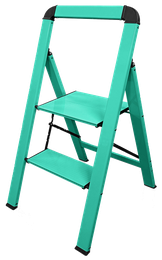FREE shipping on orders over $49!* Details
- All Products
- Housekeeping & Laundry
- Ladders & Step Stools
Ladders and Step Stools
12 Results
Sort by:
Price
12 Results
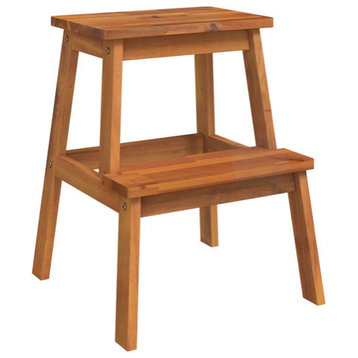
vidaXL 2 Step Stool Kitchen Step Stool Ladder for Living Room Solid Wood Acaciaby vidaXL LLC
$71
Free Shipping
- This wooden 2 step stool exudes a rustic charm and is a practical contemporary accessory for your kitchen, living room and any place.
- Solid acacia wood: Solid acacia wood is a beautiful natural material. Acacia wood is a tropical hardwood, which is dense, sturdy, and durable.
- Wide application: The step ladder can be used to help kids reach the sink and take items on their own, which will develop their independent self-care ability. Adults can also use it to pick up high items, or as a plant stool, a bathroom stool, etc.
- Curved edges: The kitchen stool is designed with curved edges to reduce your injuries due to bumping.
Note:
- The colors may vary from piece to piece, making each piece unique and slightly different from the next. The delivery is random, ensuring the exclusivity and individuality of your product.
- Each product comes with an assembly manual in the box for easy assembly.
- Material: Solid acacia wood with an oil finish
- Dimensions: 15.7" x 15" x 19.7" (W x D x H)
- Top size: 14.2" x 9.4" (L x W)
- Maximum weight capacity: 352.7 lb
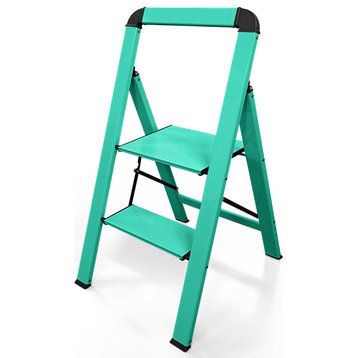
2 Step Ladder Foldable Step Stool Safety Anti-Slip Pedal 330lbs Max, Greenby Mega Casa inc.
$54
Free Shipping
This ladder comes fully assembled, and the modern color design is ideal for blending with your home's decor. Also, you will be surprised at the places it can be stored. What's Included?
Safety, stability, and security WFX utility's aluminum 2-step step stool features an enlarged non-slip pattern top platform. The locking buckle mechanism and rubber feet do not shift, allowing you to plant both feet securely in place while providing heel-to-toe foot support and preventing scratches on the floor. Portable, lightweight, and space-saving for storage, the stepladder folds down to just 1.65" d. It folds up small enough to fit into small spaces. The lightweight aluminum construction folds up easily and weighs only 7.10 lbs. As a result, it is convenient for carrying, storing, and transporting. This can be used indoors, outdoors, in the kitchen, or anywhere else in your home. Multi-use and versatile this WFX utility™ ladder can be used in multiple ways. It acts as a chair or stepping-stone for small pets. If you're looking for a visually appealing ladder, you don't have to look far! It provides extra height for cleaning, painting, or just reaching out. It's perfect for you.
Safety, stability, and security WFX utility's aluminum 2-step step stool features an enlarged non-slip pattern top platform. The locking buckle mechanism and rubber feet do not shift, allowing you to plant both feet securely in place while providing heel-to-toe foot support and preventing scratches on the floor. Portable, lightweight, and space-saving for storage, the stepladder folds down to just 1.65" d. It folds up small enough to fit into small spaces. The lightweight aluminum construction folds up easily and weighs only 7.10 lbs. As a result, it is convenient for carrying, storing, and transporting. This can be used indoors, outdoors, in the kitchen, or anywhere else in your home. Multi-use and versatile this WFX utility™ ladder can be used in multiple ways. It acts as a chair or stepping-stone for small pets. If you're looking for a visually appealing ladder, you don't have to look far! It provides extra height for cleaning, painting, or just reaching out. It's perfect for you.
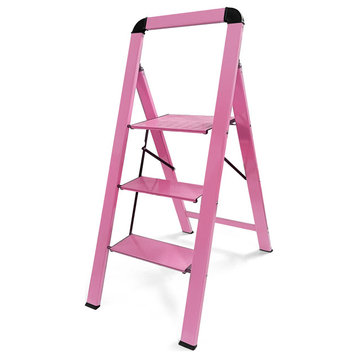
3 - Step Aluminum Folding Step Stool, Pinkby Mega Casa inc.
$64
Free Shipping
SponsoredIntroducing the 3-Step Aluminum Folding Step Stool, the perfect tool for reaching high places with confidence and convenience. Designed with a reliable locking buckle mechanism and non-slip rubber feet, this step stool ensures that both of your feet stay securely planted, offering exceptional heel-to-toe foot support while also preventing any scratches on your floors. You can now tackle household tasks or access those out-of-reach items with ease and peace of mind.
Weighing in at just 7.9 pounds, the 3-Step Aluminum Folding Step Stool is a lightweight marvel. The sturdy yet lightweight aluminum construction makes it easy to fold and unfold, allowing for quick setup and effortless transportation. Whether you need to carry it from room to room or take it on the go for various tasks, this step stool has got you covered.
Not only is this step stool practical, but it is also incredibly versatile. It can be utilized in multiple ways, whether you need a boost in the kitchen to access those high shelves or require assistance with household chores such as changing light bulbs or cleaning hard-to-reach areas. Its versatility extends beyond the home as well, making it a handy tool in workshops, garages, or outdoor settings.
To top it off, the 3-Step Aluminum Folding Step Stool is available in three vibrant colors: purple, pink, and blue. These bright and captivating color options are a great point, as they can bring a touch of personality and style to your space. The step stool not only serves its purpose but also adds a delightful pop of color to your home decor. Choose the color that resonates with your style and enjoy the visual appeal it brings to your surroundings.
In summary, the 3-Step Aluminum Folding Step Stool is the epitome of security, compactness, and style. With its secure locking buckle mechanism, non-slip rubber feet, and compact folding design, it guarantees stability and safety for all your high-reaching needs. Its lightweight aluminum construction ensures easy portability, while the vibrant color options make it an eye-catching addition to any space. Don't miss out on this versatile and aesthetically pleasing step stool that combines functionality with a splash of color to enhance your home.
- What's Included?
- Folding Capability
- Slip-Resistant Feet
- Slip-Resistant Steps
Features
When it comes to storage, this step stool truly shines. With its innovative folding design, it collapses down to an impressively slim 1.65 inches in depth. This means you can effortlessly stow it away in tight spaces such as closets, and cabinets, or even slide it under furniture, maximizing your available storage area. No more bulky or cumbersome step stools cluttering up your home.Weighing in at just 7.9 pounds, the 3-Step Aluminum Folding Step Stool is a lightweight marvel. The sturdy yet lightweight aluminum construction makes it easy to fold and unfold, allowing for quick setup and effortless transportation. Whether you need to carry it from room to room or take it on the go for various tasks, this step stool has got you covered.
Not only is this step stool practical, but it is also incredibly versatile. It can be utilized in multiple ways, whether you need a boost in the kitchen to access those high shelves or require assistance with household chores such as changing light bulbs or cleaning hard-to-reach areas. Its versatility extends beyond the home as well, making it a handy tool in workshops, garages, or outdoor settings.
To top it off, the 3-Step Aluminum Folding Step Stool is available in three vibrant colors: purple, pink, and blue. These bright and captivating color options are a great point, as they can bring a touch of personality and style to your space. The step stool not only serves its purpose but also adds a delightful pop of color to your home decor. Choose the color that resonates with your style and enjoy the visual appeal it brings to your surroundings.
In summary, the 3-Step Aluminum Folding Step Stool is the epitome of security, compactness, and style. With its secure locking buckle mechanism, non-slip rubber feet, and compact folding design, it guarantees stability and safety for all your high-reaching needs. Its lightweight aluminum construction ensures easy portability, while the vibrant color options make it an eye-catching addition to any space. Don't miss out on this versatile and aesthetically pleasing step stool that combines functionality with a splash of color to enhance your home.
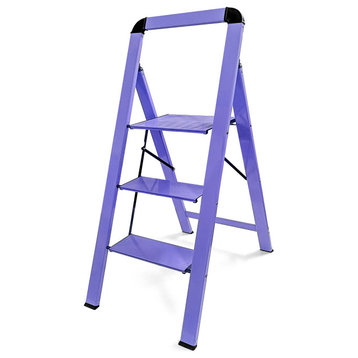
3 - Step Aluminum Folding Step Stool, Purpleby Mega Casa inc.
$64
Free Shipping
Introducing the 3-Step Aluminum Folding Step Stool, the perfect tool for reaching high places with confidence and convenience. Designed with a reliable locking buckle mechanism and non-slip rubber feet, this step stool ensures that both of your feet stay securely planted, offering exceptional heel-to-toe foot support while also preventing any scratches on your floors. You can now tackle household tasks or access those out-of-reach items with ease and peace of mind.
Weighing in at just 7.9 pounds, the 3-Step Aluminum Folding Step Stool is a lightweight marvel. The sturdy yet lightweight aluminum construction makes it easy to fold and unfold, allowing for quick setup and effortless transportation. Whether you need to carry it from room to room or take it on the go for various tasks, this step stool has got you covered.
Not only is this step stool practical, but it is also incredibly versatile. It can be utilized in multiple ways, whether you need a boost in the kitchen to access those high shelves or require assistance with household chores such as changing light bulbs or cleaning hard-to-reach areas. Its versatility extends beyond the home as well, making it a handy tool in workshops, garages, or outdoor settings.
To top it off, the 3-Step Aluminum Folding Step Stool is available in three vibrant colors: purple, pink, and blue. These bright and captivating color options are a great point, as they can bring a touch of personality and style to your space. The step stool not only serves its purpose but also adds a delightful pop of color to your home decor. Choose the color that resonates with your style and enjoy the visual appeal it brings to your surroundings.
In summary, the 3-Step Aluminum Folding Step Stool is the epitome of security, compactness, and style. With its secure locking buckle mechanism, non-slip rubber feet, and compact folding design, it guarantees stability and safety for all your high-reaching needs. Its lightweight aluminum construction ensures easy portability, while the vibrant color options make it an eye-catching addition to any space. Don't miss out on this versatile and aesthetically pleasing step stool that combines functionality with a splash of color to enhance your home.
- What's Included?
- Folding Capability
- Slip-Resistant Feet
- Slip-Resistant Steps
Features
When it comes to storage, this step stool truly shines. With its innovative folding design, it collapses down to an impressively slim 1.65 inches in depth. This means you can effortlessly stow it away in tight spaces such as closets, and cabinets, or even slide it under furniture, maximizing your available storage area. No more bulky or cumbersome step stools cluttering up your home.Weighing in at just 7.9 pounds, the 3-Step Aluminum Folding Step Stool is a lightweight marvel. The sturdy yet lightweight aluminum construction makes it easy to fold and unfold, allowing for quick setup and effortless transportation. Whether you need to carry it from room to room or take it on the go for various tasks, this step stool has got you covered.
Not only is this step stool practical, but it is also incredibly versatile. It can be utilized in multiple ways, whether you need a boost in the kitchen to access those high shelves or require assistance with household chores such as changing light bulbs or cleaning hard-to-reach areas. Its versatility extends beyond the home as well, making it a handy tool in workshops, garages, or outdoor settings.
To top it off, the 3-Step Aluminum Folding Step Stool is available in three vibrant colors: purple, pink, and blue. These bright and captivating color options are a great point, as they can bring a touch of personality and style to your space. The step stool not only serves its purpose but also adds a delightful pop of color to your home decor. Choose the color that resonates with your style and enjoy the visual appeal it brings to your surroundings.
In summary, the 3-Step Aluminum Folding Step Stool is the epitome of security, compactness, and style. With its secure locking buckle mechanism, non-slip rubber feet, and compact folding design, it guarantees stability and safety for all your high-reaching needs. Its lightweight aluminum construction ensures easy portability, while the vibrant color options make it an eye-catching addition to any space. Don't miss out on this versatile and aesthetically pleasing step stool that combines functionality with a splash of color to enhance your home.
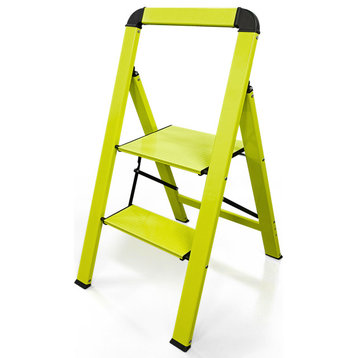
2 Step Ladder Foldable Step Stool Safety Anti-Slip Pedal 330lbs Max, Yellowby Mega Casa inc.
$54
Free Shipping
This ladder comes fully assembled, and the modern color design is ideal for blending with your home's decor. Also, you will be surprised at the places it can be stored. What's Included?
Safety, stability, and security WFX utility's aluminum 2-step step stool features an enlarged non-slip pattern top platform. The locking buckle mechanism and rubber feet do not shift, allowing you to plant both feet securely in place while providing heel-to-toe foot support and preventing scratches on the floor. Portable, lightweight, and space-saving for storage, the stepladder folds down to just 1.65" d. It folds up small enough to fit into small spaces. The lightweight aluminum construction folds up easily and weighs only 7.10 lbs. As a result, it is convenient for carrying, storing, and transporting. This can be used indoors, outdoors, in the kitchen, or anywhere else in your home. Multi-use and versatile this WFX utility™ ladder can be used in multiple ways. It acts as a chair or stepping-stone for small pets. If you're looking for a visually appealing ladder, you don't have to look far! It provides extra height for cleaning, painting, or just reaching out. It's perfect for you.
Safety, stability, and security WFX utility's aluminum 2-step step stool features an enlarged non-slip pattern top platform. The locking buckle mechanism and rubber feet do not shift, allowing you to plant both feet securely in place while providing heel-to-toe foot support and preventing scratches on the floor. Portable, lightweight, and space-saving for storage, the stepladder folds down to just 1.65" d. It folds up small enough to fit into small spaces. The lightweight aluminum construction folds up easily and weighs only 7.10 lbs. As a result, it is convenient for carrying, storing, and transporting. This can be used indoors, outdoors, in the kitchen, or anywhere else in your home. Multi-use and versatile this WFX utility™ ladder can be used in multiple ways. It acts as a chair or stepping-stone for small pets. If you're looking for a visually appealing ladder, you don't have to look far! It provides extra height for cleaning, painting, or just reaching out. It's perfect for you.
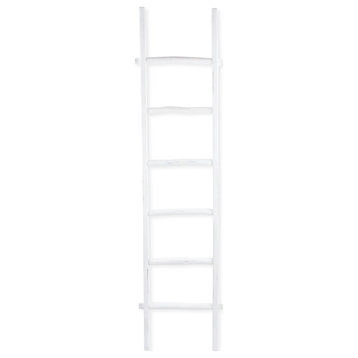
Atwater Rustic White Ladderby Cheungs
$107
Free Shipping
Handcrafted with natural wood materials, this ladder makes the perfect accent to your rustic styled space. Our Atwater Ladder is great for livening up an empty space and making it more warm and inviting. For additional farmhouse accenting try hanging some blankets from the rungs!
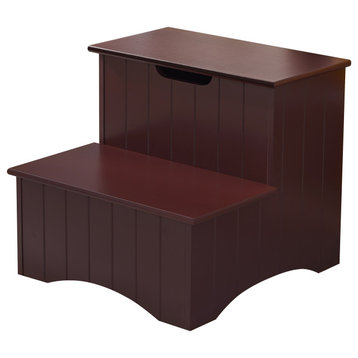
Joshua Step Stool With Storage (Walnut)by Kings Brand Furniture
$97
Free Shipping
This 2-step stool looks classy and elegant in your home, while being multi-functional. It can be used as a step stool and also as storage. The top step swings open with a lower panel beneath forming a small chest for storing items. Made from MDF wood and finished in a rich color, this stool is both sturdy and elegant. Clean lines add traditional class to the piece. Different colors available for purchase.
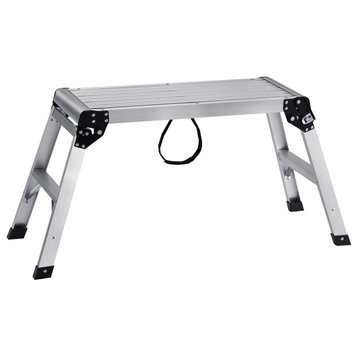
VEVOR Aluminum Folding Work Platform Drywall Ladder 330lbs Non-slip Benchby VEVOR
$61
Free Shipping
VEVOR Folding Platform Makes Work More Comfortable
Are you working alone on repairs or painting high places? If so, you need a reliable and safe platform to assist you. A high-strength aluminum step stool boasts an impressive loading capacity of 330 lbs, providing a reliable and secure working surface for all your projects.
Folds with Ease: The work platform can be easily folded and unfolded in seconds thanks to its folding mechanism that saves time and effort when moving between different work areas or during transportation and storage. Unfold size: 29.9'' x 11.8'' x 20"(L*W*H) ; Fold Size: 29.9'' x 11.8'' x 5.5"(L*W*H), making it easy to store in limited spaces.
Easy-carry Platform: The drywall stool ladder is lightweight and features specially designed Velcro to provide a secure hold and prevent the four legs from falling apart, saving you a lot of trouble during handling or storage.
Rock-Solid Stability: Our aluminum platform’s surface offers excellent traction, reducing the risk of slips and falls. Four legs covered with non-slip plastic feet enhances stability and provides strong support to prevent any unwanted movement or swaying. This design ensures your security, even when used in rainy conditions.
Versatility at Its Finest: A adjustable work platform enables you to access hard-to-reach areas, eliminating the need for ladders or scaffolding. It is ideal for a wide range of indoor and outdoor applications, including home DIY projects, vehicle washing, reaching high places, and general maintenance work.
Are you working alone on repairs or painting high places? If so, you need a reliable and safe platform to assist you. A high-strength aluminum step stool boasts an impressive loading capacity of 330 lbs, providing a reliable and secure working surface for all your projects.
Features & Details
Ultimate Durable Aluminum: Our folding platform is crafted from top-notch aluminum, ensuring resistance to rust and corrosion. Our platforms feature an impressive load capacity of up to 330 lbs, effortlessly bearing the weight of heavy equipment, materials, and tools.Folds with Ease: The work platform can be easily folded and unfolded in seconds thanks to its folding mechanism that saves time and effort when moving between different work areas or during transportation and storage. Unfold size: 29.9'' x 11.8'' x 20"(L*W*H) ; Fold Size: 29.9'' x 11.8'' x 5.5"(L*W*H), making it easy to store in limited spaces.
Easy-carry Platform: The drywall stool ladder is lightweight and features specially designed Velcro to provide a secure hold and prevent the four legs from falling apart, saving you a lot of trouble during handling or storage.
Rock-Solid Stability: Our aluminum platform’s surface offers excellent traction, reducing the risk of slips and falls. Four legs covered with non-slip plastic feet enhances stability and provides strong support to prevent any unwanted movement or swaying. This design ensures your security, even when used in rainy conditions.
Versatility at Its Finest: A adjustable work platform enables you to access hard-to-reach areas, eliminating the need for ladders or scaffolding. It is ideal for a wide range of indoor and outdoor applications, including home DIY projects, vehicle washing, reaching high places, and general maintenance work.
Specifications
- Item Model: SW-WP001
- Item Height: 20'' / 50.8 cm
- Item Length: 29.9'' / 76 cm
- Item Width: 11.8'' / 30 cm
- Load Capacity: 330 lbs / 150 kg
- Material: Aluminum
- Item Weight: 7.9 lbs / 3.6 kg
- Package Content
- 1 x Work Platform
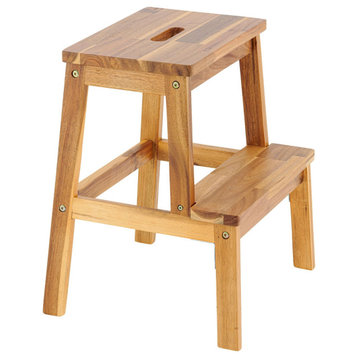
Gewnee Wood Two Steps Stool Small Sizeby Gewnee
$85
Free Shipping
This 2-step stool from BEEFURNI is made of premium grade acacia wood that is super durable. This wooden ladder stool comes with a rectangular shaped top and 4 strong legs. The measurements of this stool are 19.7-inch length x 18.2-inch width x 16.8-inch height. The height of the first step is 9.8 inches. This stool is designed to be water resistant, so its easy to care and clean and can be used in a bathroom. It makes a perfect step stool or footstool for both adults and kids. Its also easy to assemble for everyone!
American Trails Decorative Ladder, Natural Rubberwoodby American Trails
$160
Free Shipping
Made of 100% solid wood, this Decorative Ladder will add the perfect touch of class and balance to any room. Simply lean the ladder where you think it fits best. Take it a step further by using the rungs as platforms for other decorative accents to hang or hold. Its design will resonate harmoniously with any wooden or antique furnishings. Lend a vintage atmosphere to your room.
Wayborn Birchwood Ladder Stand in Whiteby Wayborn Home Furnishing Inc
$202
Free Shipping
This shelf unit is great to display items either leaning on a wall or free standing between two rooms. This ladder style shelf starts with a small shelf on top and get larger as you move down the unit. Simple, sturdy yet functional able to hold books, magazines or to just display décor in your home. This will be a wonderful addition to a small space like a bedroom or dorm that is in need of a little organization.
Features :
- Sturdy ladder style shelf unit
- Sturdy ladder style shelf unit
- Easy assembly
Specifications :
- Assembly Required : Yes
- Shelf Dimensions : 10Hx22Wx Top to bottom depth is 11.25, 13.5 & 16"D
- Product Dimensions : 22x19x44"H
- Shelf Material : Wood
Wayborn Birchwood Ladder Stand in Blackby Wayborn Home Furnishing Inc
$217
Free Shipping
This shelf unit is great to display items either leaning on a wall or free standing between two rooms. This ladder style shelf starts with a small shelf on top and get larger as you move down the unit. Simple, sturdy yet functional able to hold books, magazines or to just display décor in your home. This will be a wonderful addition to a small space like a bedroom or dorm that is in need of a little organization.
Features :
- Sturdy ladder style shelf unit
- Sturdy ladder style shelf unit
- Easy assembly
Specifications :
- Assembly Required : Yes
- Shelf Dimensions : 10Hx22Wx Top to bottom depth is 11.25, 13.5 & 16"D
- Product Dimensions : 22x19x44"H
- Shelf Material : Wood
- Shelf Weight Capacity : 5 - 10 lbs.
Whether you have tall kitchen cabinets, hard-to-reach attic space, or are just a bit vertically challenged, a ladder or step stool is essential. While ladders tend to be your faithful outdoor workhorses, step stools are your best friends in the kitchen or closet. Along with being practical, styles like a library ladder can add to your décor. As you shop for ladders or step stools, keep these considerations in mind:
Choosing the right style depends on what sort of tasks you plan to undertake. In terms of practical use, there are two main designs:
• Extension ladder: If you’re looking for a way to get up on your roof, this should do the trick. These typically range in height from 16 to 40 feet and are designed to have you stand no higher than the fourth rung from the top. Instead of being self-supporting like an A-frame ladder, they’re designed to lean up against your house or another sturdy surface.
• A-frame ladder: These range in size from a shorter step stool style all the way to taller styles that can be used to hang artwork or reach those top-level shelves.
Stability and safety are huge factors when it comes to choosing the right material. Keep in mind what you plan to use yours for when picking a material.
• Wood: An affordable and durable option, wood also looks great. If you’ll be moving around or working outdoors, be aware that it tends to be a heavier option that’s prone to weathering.
• Aluminum: This lightweight option is perfect for the majority of home use. However, if you plan to do some electrical work, be aware it is conductive.
• Fiberglass: The electrician or roofer’s top choice, these ladders are non-conductive, durable and strong. It’s a bit heavier than aluminum, though.
Even if you’re simply adding a couple of inches onto your height with your folding step stool, it’s wise to keep safety in mind. Here are a few tips to keep your ascent and descent as safe as possible.
• Only use ladders and step stools for their intended purposes.
• Refrain from setting up on an unstable or rough surface.
• Take care when storing your ladder or step stool. Be sure it’s secured and won’t fall over on people or present a tripping hazard.
• Be sure all locks are properly secured before climbing up.
• Keep a three-point contact when climbing and always face the ladder. A three-point contact can be two hands and a foot or two feet and a hand.
• Avoid stepping on the top rung unless it’s intended for that purpose. Most ladders will be marked to indicate whether you can take that final step.
What type of ladder or step stool do I need?
Choosing the right style depends on what sort of tasks you plan to undertake. In terms of practical use, there are two main designs:
• Extension ladder: If you’re looking for a way to get up on your roof, this should do the trick. These typically range in height from 16 to 40 feet and are designed to have you stand no higher than the fourth rung from the top. Instead of being self-supporting like an A-frame ladder, they’re designed to lean up against your house or another sturdy surface.
• A-frame ladder: These range in size from a shorter step stool style all the way to taller styles that can be used to hang artwork or reach those top-level shelves.
Should my ladder be made of a certain material?
Stability and safety are huge factors when it comes to choosing the right material. Keep in mind what you plan to use yours for when picking a material.
• Wood: An affordable and durable option, wood also looks great. If you’ll be moving around or working outdoors, be aware that it tends to be a heavier option that’s prone to weathering.
• Aluminum: This lightweight option is perfect for the majority of home use. However, if you plan to do some electrical work, be aware it is conductive.
• Fiberglass: The electrician or roofer’s top choice, these ladders are non-conductive, durable and strong. It’s a bit heavier than aluminum, though.
Are there any safety tips I should follow when using my step stool or ladder?
Even if you’re simply adding a couple of inches onto your height with your folding step stool, it’s wise to keep safety in mind. Here are a few tips to keep your ascent and descent as safe as possible.
• Only use ladders and step stools for their intended purposes.
• Refrain from setting up on an unstable or rough surface.
• Take care when storing your ladder or step stool. Be sure it’s secured and won’t fall over on people or present a tripping hazard.
• Be sure all locks are properly secured before climbing up.
• Keep a three-point contact when climbing and always face the ladder. A three-point contact can be two hands and a foot or two feet and a hand.
• Avoid stepping on the top rung unless it’s intended for that purpose. Most ladders will be marked to indicate whether you can take that final step.








